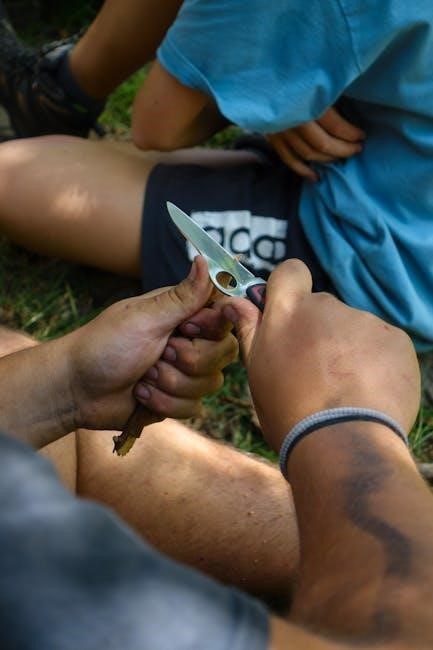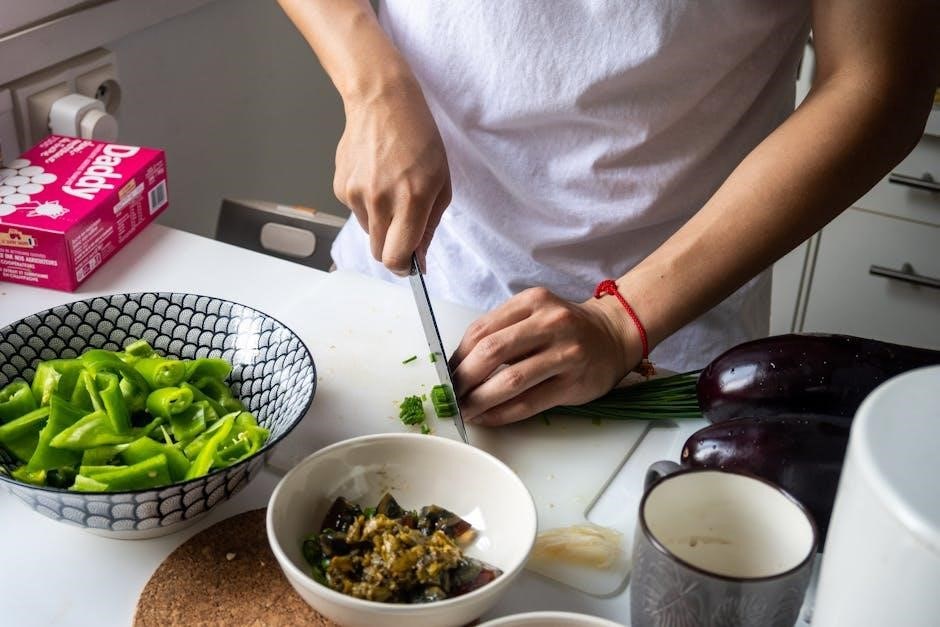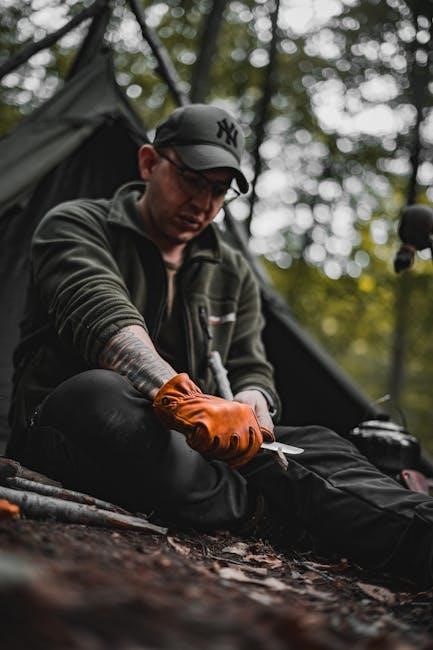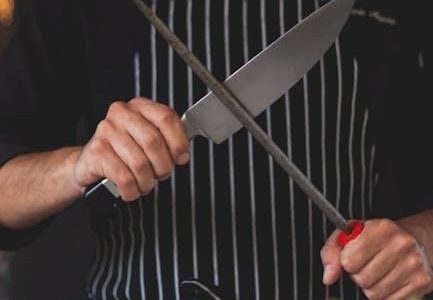Knife sharpening is an essential skill for maintaining functionality. It transforms a dull blade into a precise tool, requiring the right techniques and tools. Consistency is key; This guide offers a comprehensive approach for all skill levels.
Importance of Knife Sharpening
Knife sharpening is crucial for maintaining efficiency and safety in both culinary and outdoor activities. A sharp blade reduces the effort needed for cutting, minimizing the risk of accidents caused by slipping or applying excessive force. Dull knives require more pressure, increasing the likelihood of injury. Regular sharpening extends the lifespan of the knife, preventing premature wear and tear. Additionally, a well-maintained edge ensures precise cuts, preserving the quality of materials being cut, whether in cooking or crafting. Sharpening also fosters a deeper connection to the tools, encouraging a mindset of care and maintenance. Ultimately, it enhances performance, safety, and longevity, making it an indispensable skill for anyone relying on knives.
Basic Concepts of Knife Sharpening
Knife sharpening revolves around understanding the blade’s edge geometry and the sharpening process. The primary goal is to create a sharp, consistent edge by removing metal through controlled strokes. Key concepts include the bevel, the angle at which the blade is sharpened, and the grit of sharpening tools, which range from coarse to fine. The process involves progressing through increasingly finer grits to refine the edge. Techniques vary between tools like whetstones, sharpening steels, and electric sharpeners, each with specific methods. Proper posture and stroke consistency are vital for achieving an even edge. Mastery of these fundamentals ensures effective sharpening, regardless of the tool or method chosen. Regular practice enhances skill and efficiency, making sharpening a straightforward task.

Choosing the Right Tools for Knife Sharpening
Selecting the right tools is crucial for effective knife sharpening. Whetstones, electric sharpeners, and sharpening steels are popular options, each offering unique benefits for different skill levels and needs.
Whetstones: Types and Uses
Whetstones are a cornerstone of knife sharpening, available in various types to suit different needs. Water stones, known for their soft abrasive layers, are ideal for fine sharpening and require soaking before use. Oil stones, more durable, use oil to prevent clogging and are great for coarse sharpening. Ceramic stones offer a hybrid option, combining durability with water or oil use. Diamond stones, with embedded diamonds, are excellent for aggressive sharpening and resetting edges. Each type caters to specific sharpening goals, from refining edges to heavy repair. Proper maintenance, like cleaning and flattening, ensures longevity. Consistent use of the correct grit progression enhances sharpness effectively, making whetstones indispensable for both beginners and experts. Mastering their use elevates sharpening precision and consistency.
Electric Knife Sharpeners: Pros and Cons
Electric knife sharpeners offer convenience and speed, ideal for those seeking quick results. They often feature multiple stages for coarse and fine sharpening, ensuring a polished edge. These devices are user-friendly, requiring minimal skill, and are perfect for consistent sharpening. However, they can be overly aggressive, removing excessive metal, especially from high-quality knives. Heat generation during use may damage blades if not monitored. Additionally, electric sharpeners are less portable and more expensive than manual tools. While they are efficient for home use, they may not suit precision or antique knives. For casual users, they provide a hassle-free experience, but enthusiasts may prefer traditional methods for better control and blade preservation.
Ceramic and Diamond Stones: Effective Options
Ceramic and diamond stones are popular choices for knife sharpening due to their durability and effectiveness. Ceramic stones are ideal for fine sharpening and polishing, offering a smooth surface that maintains a consistent edge. Diamond stones, on the other hand, are highly aggressive, making them perfect for repairing damaged or extremely dull blades. They are versatile, often used for both straight and serrated edges. Both types are easy to clean and require minimal maintenance, making them convenient for sharpening at home or in professional settings. While ceramic stones may take longer to achieve desired sharpness, diamond stones work quickly but can wear down faster. Together, they provide a reliable solution for maintaining knife sharpness across various situations.
Sharpening Steels: Maintenance and Use
Sharpening steels, also known as honing steels, are essential tools for maintaining a knife’s edge. They are not used for sharpening but for refining and aligning the blade’s microteeth. To use a sharpening steel effectively, hold it firmly and draw the knife along its surface at the desired angle, using light, consistent strokes. Regular use prevents the knife from becoming dull and extends its lifespan. Maintenance involves cleaning the steel to remove metal particles and storing it in a dry place to prevent rust. Proper care ensures the steel remains effective and prolongs the knife’s sharpness. Sharpening steels are a quick and practical solution for everyday knife maintenance, ideal for both home cooks and professionals.

Understanding the Sharpening Angle
The sharpening angle is a critical factor in achieving an effective edge. It ensures consistency and precision, varying depending on the knife’s intended use and design.
What is the Sharpening Angle?
The sharpening angle refers to the precise angle at which the knife’s edge meets the sharpening tool. It is a critical factor in achieving a sharp, durable edge; This angle varies depending on the type of knife and its intended use, with straight-edge knives typically requiring a 20-degree angle, while precision or fillet knives may use a narrower 10-15 degrees. The angle determines how the blade interacts with the sharpening surface, ensuring consistent results. Properly maintaining this angle ensures the knife’s performance and longevity, making it essential to understand and master for effective sharpening. This foundational concept is vital for both novice and experienced sharpeners alike.
How to Choose the Right Angle for Your Knife
Selecting the correct sharpening angle begins with understanding your knife’s purpose. Straight-edge knives, such as chef’s knives, typically use a 20-degree angle for versatility and durability. Precision knives, like fillet knives, benefit from a narrower 10-15 degrees to maintain sharpness. The angle choice affects the blade’s edge geometry, with steeper angles (25-30 degrees) better for heavy-duty tasks requiring robust edges. Lighter tasks, such as slicing, may use shallower angles (15-20 degrees) for a finer edge. Always refer to the manufacturer’s guidelines for specific recommendations, as some knives are designed for optimal performance at particular angles; Experimentation and practice help refine the ideal angle for your knife’s intended use, ensuring efficiency and longevity.
Common Sharpening Angles for Different Knives
Sharpening angles vary based on knife type and usage. Chef’s knives and general-purpose knives typically use a 20-25° angle for balance between sharpness and durability. Serrated knives often require a narrower 10-15° angle to maintain their unique edge. Paring knives benefit from a slightly sharper 15-20° angle for precision cuts. Heavy-duty knives, like cleavers, may use a steeper 25-30° angle for robustness. The angle choice directly impacts the knife’s performance, with steeper angles creating more durable edges and shallower angles producing sharper blades. Always consider the knife’s intended use when selecting the angle, as this ensures optimal results. Refer to manufacturer guidelines for specific recommendations, and practice to refine your technique for the best outcomes.

Preparing for the Sharpening Process
Preparing for sharpening involves inspecting the knife for damage, preparing the sharpening tool, and setting up a stable, well-lit workspace to ensure safety and precision.
Inspecting the Knife Before Sharpening
Inspecting the knife before sharpening is crucial for identifying issues that may affect the process. Examine the edge for dullness, chips, or rust. Check the spine and handle for damage or looseness. Ensure the blade is straight and free of warping. Clean the knife to remove dirt or debris that could interfere with sharpening. Visually assess the bevel angle to determine if it needs adjustment. Inspect the sharpening tool for wear or damage. Proper inspection ensures a safe and effective sharpening process, helping you achieve the desired edge. Addressing issues beforehand prevents further damage and ensures optimal results. A thorough inspection sets the foundation for successful knife sharpening.
Preparing the Sharpening Tool
Preparing the sharpening tool is essential for achieving optimal results. Start by cleaning the tool to remove any debris or residue. For whetstones, soak them in water or oil as recommended. Ensure the surface is flat and even, using a stone fixer if necessary. Align the tool at the correct angle, typically between 20° and 30°, depending on the knife type. Check for any damage or wear on the tool and address it before use. Properly securing the tool on a stable surface prevents movement during sharpening. Finally, test the tool on a dull edge to ensure it is functioning correctly. A well-prepared sharpening tool guarantees consistency and precision, making the sharpening process safer and more effective.
Setting Up Your Sharpening Environment
Setting up a proper sharpening environment ensures safety and efficiency. Begin by choosing a stable, flat surface, such as a countertop or workbench. Good lighting is essential to clearly see the knife’s edge. Clear the area of clutter to prevent accidents and keep tools within easy reach. Protect the surface with a rubber mat or similar material to prevent slipping. Wear protective gloves if you’re new to sharpening. Position the sharpening tool at a comfortable height to avoid strain. Ensure the area is well-ventilated, especially when using water or oil stones. Having a clean, dry cloth nearby helps wipe away metal particles and maintain visibility. A well-prepared environment enhances focus and precision, making the sharpening process safer and more effective.
The Sharpening Process
The sharpening process involves progressing through grits, starting coarse for shaping and refining with finer stones. Consistent, controlled strokes ensure an even edge, patience yielding optimal results.
Step 1: Starting with a Coarse Grit Stone
Begin sharpening by using a coarse grit stone to establish the knife’s edge. Hold the knife at the correct angle and draw it across the stone in smooth, consistent strokes. Repeat this process on both sides of the blade to ensure even sharpening. The coarse grit removes metal quickly, shaping the edge to the desired sharpness. It’s important to maintain the same angle throughout to avoid uneven results. After several strokes, inspect the edge to gauge progress. Once the blade shows a visible edge, it’s ready for refinement with a finer grit stone. Patience is key in this foundational step.
Step 2: Progressing to a Fine Grit Stone
Once the knife has been sharpened with a coarse grit stone, switch to a fine grit stone to refine the edge. Hold the knife at the same angle and continue stroking, focusing on polishing the blade. Use lighter pressure and fewer strokes—typically 10-15 per side—to avoid overheating the steel. The fine grit removes minor imperfections, creating a sharper, more precise edge. Inspect the blade after each stroke to monitor progress. If the knife is sufficiently sharp, you may stop here. Otherwise, proceed to an even finer grit or use a sharpening steel for final touches. This step ensures a smooth, razor-sharp edge, ready for everyday use.
Step 3: Maintaining Consistent Strokes
Maintaining consistent strokes is crucial for achieving a sharp, even edge. Start each stroke at the heel and move toward the tip, keeping the angle steady. Apply moderate pressure, increasing slightly as you progress. Use a smooth, controlled motion, avoiding jerky movements that can damage the blade. After each stroke, inspect the edge to ensure uniform sharpening. If the knife begins to feel sticky or the stone becomes clogged, clean it with water or oil. Consistency ensures the blade sharpens evenly, preventing uneven wear. Regular practice will help develop muscle memory, making the process more efficient and effective over time. This step is vital for mastering the sharpening technique and achieving professional results.
Step 4: Flipping the Knife and Repeating
Once you’ve sharpened one side of the knife, carefully flip it over to sharpen the other side. Maintain the same angle and stroke pattern to ensure an even edge. After each stroke on the new side, inspect the blade to check for progress. Repeat the process, alternating sides, until the edge begins to show a consistent sharpness. As you flip, pay attention to the knife’s balance and ensure you’re applying the same pressure and angle on both sides. This step is critical for achieving a symmetrical edge and preventing uneven wear. Continue flipping and sharpening until the desired sharpness is reached, then move to finer grit stones for polishing. Consistency and patience are key to a professional finish.

Testing the Edge
Testing the knife’s sharpness involves simple methods like cutting paper or a thumbnail. A sharp blade will slice cleanly and precisely, confirming its readiness for use.
Methods to Test Sharpness
Testing a knife’s edge is crucial to ensure its sharpness. One common method is cutting a piece of paper; a sharp blade will slice cleanly and effortlessly. Another technique involves lightly drawing the knife across a thumbnail—if it bites in with minimal pressure, it’s sharp. Additionally, shaving hair from a arm or leg can indicate razor-sharpness. For kitchen knives, slicing through a ripe tomato or thin skinned fruit reveals edge performance. These methods provide quick, practical ways to assess sharpness effectively. Consistent testing helps maintain blade performance and ensures safety during use. Always handle the knife with care during these tests to avoid accidents. Sharpness testing is a key step in knife maintenance and use.
Using a Sharpening Steel for Final Touches
A sharpening steel, or honing steel, is essential for refining a knife’s edge. After sharpening, the steel aligns the blade’s microteeth, ensuring a polished finish. Hold the steel vertically and draw the knife across it at the desired angle, alternating sides with light pressure. This process removes any remaining burrs and enhances sharpness. Regular honing maintains the edge between sharpening sessions. Steel types vary; ceramic and diamond steels offer more aggressive refining, while traditional steels provide a gentle touch. Proper technique is key to achieving a razor-sharp edge. Using a sharpening steel is a quick and effective way to finalize knife sharpening, ensuring optimal performance for cutting tasks. It complements other sharpening tools, making it a vital step in knife care.
Maintenance and Storage
Regular cleaning and drying prevent rust. Store knives in dry places, using sheaths or blocks. Proper care extends sharpness and prevents damage, ensuring longevity and safety.
Cleaning and Drying the Knife
Cleaning and drying are vital for maintaining a knife’s condition. After sharpening, use mild soap and warm water to remove metal particles and residue. Avoid harsh chemicals, as they can damage the blade or handle. Scrub gently with a soft cloth or brush, paying attention to crevices where debris may accumulate. Rinse thoroughly and pat dry with a clean, absorbent cloth. For added protection, apply a small amount of food-safe oil to the blade to prevent rust. Regular cleaning prevents corrosion and ensures the knife remains hygienic for use. Proper drying and storage are essential to maintain sharpness and longevity, keeping your knife in optimal condition for years. Consistent care enhances both functionality and safety.
Proper Storage to Maintain Sharpness
Proper storage is crucial for preserving a knife’s sharpness and overall condition. Store knives in a dry, cool place away from direct sunlight to prevent rust. Avoid stacking knives together, as this can cause nicks and dulling. Use a knife block, magnetic strip, or protective sheath to keep the blade safe and secure. For added protection, consider storing knives in a hard case or pouch with individual compartments. Never store knives in a damp environment or near corrosive materials. Regularly inspect stored knives for signs of rust or damage. Proper storage prevents accidental injuries and maintains the knife’s edge, ensuring it remains sharp and ready for use. Consistent care extends the lifespan of your knives and keeps them in optimal condition.
Common Mistakes to Avoid
Common mistakes include incorrect sharpening angles, applying too much pressure, and over-sharpening. Avoid using improper tools and neglecting knife maintenance, as these can damage the blade.
Incorrect Angle Usage
Incorrect angle usage is a common mistake in knife sharpening. The angle at which the blade is sharpened significantly impacts its effectiveness. If the angle is too shallow, the knife may not hold its edge well, while too steep an angle can lead to a weak or uneven edge. Most knives require a sharpening angle between 20° and 30°, depending on their intended use. To avoid this mistake, use a sharpening guide or marker to help maintain consistency. Practicing on an old or inexpensive knife can also help develop muscle memory. Consistency in angle maintenance is crucial for achieving a sharp, durable edge. Always refer to the knife’s design or consult a guide for specific angle recommendations.
Insufficient or Excessive Sharpening
Insufficient sharpening leaves the knife dull and ineffective, while excessive sharpening removes too much metal, weakening the blade. Both mistakes are avoidable with proper technique. Recognize when the edge is sharp enough by observing its performance on materials like paper or fabric. Over-sharpening can create a fragile edge, prone to chipping. To avoid this, sharpen in controlled strokes and check progress frequently. Using sharpening tools with angle guides can help maintain consistency. Remember, the goal is a functional edge, not a polished mirror finish. Practice moderation and patience to achieve the perfect balance for your knife’s intended use. Avoid these extremes to ensure durability and performance.
Not Maintaining Tools
Failure to maintain sharpening tools can lead to ineffective results and potential damage to the knife. Clean and dry tools after use to prevent rust or corrosion. Store sharpening stones in a protective case and keep them away from direct sunlight. Regularly check for wear and tear, replacing worn-out parts when necessary. Neglecting these steps can result in uneven sharpening and a dull edge. Proper tool maintenance ensures consistent performance and extends the lifespan of your sharpening equipment. Always inspect tools before use to avoid compromising the sharpening process. Cleanliness and organization are key to achieving the best outcomes in knife sharpening.

Safety Tips
Knife sharpening requires focus and caution. Always cut away from your body and use protective gloves to prevent injuries. Keep loose clothing tied back and ensure a stable work surface to avoid accidents. Maintain a firm grip on the knife and never sharpen near children or pets. Proper lighting is essential for visibility. Store sharp tools securely after use. Prioritize safety to ensure a successful sharpening process without harm; Regular practice enhances skill and confidence, reducing risks. Always be mindful of your surroundings and tool conditions. Safety should never be compromised during any sharpening session. Stay alert and prepared to handle unexpected situations. A clean workspace minimizes hazards and improves efficiency. By following these guidelines, you can enjoy sharpening safely and effectively.
Handling the Knife Safely
Handling a knife safely during sharpening requires attention to detail and proper technique. Always maintain a firm, controlled grip, ensuring your fingers are away from the cutting edge. Keep your dominant hand on the handle and your other hand guiding the blade. Be mindful of the knife’s angle and movement, as improper handling can lead to accidental cuts. Never touch the sharp edge with your bare hands, as even a slight touch can cause injury. Use protective gear like gloves if necessary. Keep your workspace clean and well-lit to avoid distractions. Always position the knife away from your body and maintain awareness of its direction. Stay focused and avoid sharpening when fatigued. Proper handling ensures a safe and effective sharpening process.
Protecting Yourself and Your Workspace
Protecting yourself and your workspace is crucial during knife sharpening. Wear safety gloves and eyewear to prevent injuries from accidental slippage or flying particles. Ensure your workspace is stable, with a non-slip surface to keep tools secure. Keep loose clothing or long hair tied back to avoid entanglement with tools. Maintain a clean area to prevent tripping hazards. Store sharpening tools and knives out of reach of children and pets. Use a cutting board or mat to protect your work surface from damage. Proper lighting is essential for visibility, reducing the risk of accidents. Stay organized to ensure all tools are within easy reach. By taking these precautions, you create a safe environment conducive to effective sharpening. Always prioritize safety to avoid potential risks and ensure a smooth process.

Advanced Sharpening Techniques
Advanced sharpening techniques involve precision methods and custom edge geometry. Experienced sharpeners refine skills through micro-bevel creation and specialized tools, achieving superior sharpness and blade longevity.
Precision Sharpening Methods
Precision sharpening involves advanced techniques for achieving ultra-sharp edges. Using specialized tools like diamond stones or ceramic hones, sharpeners can maintain exact angles and refine edge geometry. This method ensures consistency and extends blade life. By focusing on micro-bevel creation and controlled strokes, users can attain professional-level results. Regular practice enhances muscle memory, allowing for intuitive sharpening. Proper tool maintenance is crucial to uphold precision. Combining these elements, precision sharpening transforms ordinary knives into exceptional cutting instruments, ideal for demanding tasks. Mastery requires patience and dedication to detail, making it a rewarding skill for enthusiasts and professionals alike.
Custom Edge Geometry
Custom edge geometry involves tailoring a knife’s edge to specific tasks, such as slicing, chopping, or filleting. By adjusting angles and shapes, sharpeners can optimize performance for particular uses. For instance, a straight edge excels at push cuts, while a convex edge enhances durability. The geometry must align with the blade’s intended purpose, user preference, and material. Factors like blade thickness, bevel type, and steel quality influence the design. Achieving the perfect balance requires skill and precision. Customizing edge geometry allows for personalized functionality, ensuring the knife meets exacting standards. This advanced technique enables enthusiasts to craft unique, high-performance tools tailored to their needs, making it a cornerstone of expert sharpening practices.
Using Expert-Level Tools
Expert-level tools elevate knife sharpening to new heights, offering precision and efficiency. Diamond stones and ceramic hones are favored for their durability and consistent results. Adjustable sharpening jigs provide unparalleled control, allowing for exact angle adjustments. These tools are designed for advanced sharpeners seeking uniform edges and intricate bevels. High-end steels, like polished ceramic or diamond-coated, refine edges to a mirror finish. Mastering these tools requires practice but yields exceptional sharpness and longevity. For serious enthusiasts, investing in premium equipment ensures professional-grade outcomes. Balancing technique with superior tools is key to achieving razor-sharp results consistently. Expert tools empower sharpeners to push boundaries, creating edges that excel in both form and function, making them indispensable for discerning professionals and hobbyists alike.
Knife sharpening is a skill that requires patience, practice, and the right techniques. Mastery comes with consistency, transforming everyday tools into exceptionally sharp and reliable instruments for any task.
Knife sharpening involves understanding angles, tools, and techniques. Using whetstones, electric sharpeners, or steels can achieve a sharp edge. Consistent practice improves skill. Regular maintenance ensures longevity. Proper storage prevents dulling. Avoiding common mistakes and prioritizing safety yield better results. Advanced methods refine edges further. The process transforms a dull blade into a precise tool, essential for functionality. Mastery requires patience and the right techniques. Consistency and proper care maintain sharpness, making everyday tools reliable for any task.
Encouragement to Practice and Refine Skills
Sharpening a knife is a skill that enhances both precision and safety. Regular practice refines your technique, improving efficiency. Even slight improvements can make a significant difference in performance. Patience is crucial; skill development takes time. Experiment with different tools to find your preference. Consistent practice ensures reliable results, making the process more enjoyable. Refining your skills leads to better knife maintenance and functionality, reducing the need for frequent replacements. Sharpening becomes a satisfying process when you see improvement. Embrace the journey, and with dedication, you’ll master the art of knife sharpening, enhancing your everyday tasks and culinary experiences. Keep practicing to refine your skills and maintain sharp, reliable blades.

